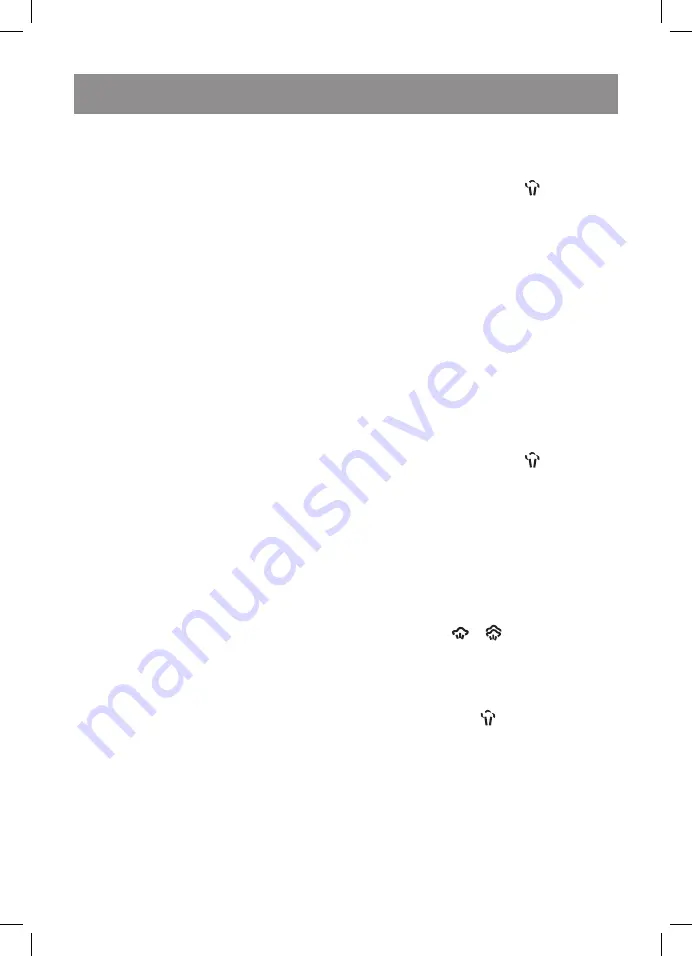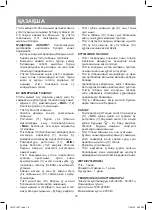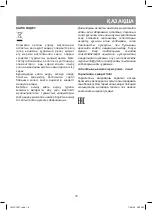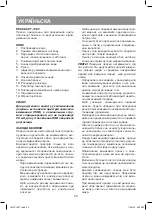
5
ENGLISH
•
This table is only valid for smooth materials.
Fabrics of other types (crimped, raised, etc.)
are best ironed at low temperature.
•
Sort items by ironing temperature first: syn-
thetics to synthetics, wool to wool, cotton to
cotton etc.
•
The iron heats up faster than it cools down.
For this reason, it is recommended to iron the
items which require low temperature first (for
instance, synthetic fabrics).
After that, start ironing at higher temperature
(silk/wool). Cotton and linen items should be
ironed last.
•
If an item is made of mixed fabrics, the iron
should be set to the lowest temperature (for
instance, if an item is 60% polyester and 40%
cotton, it should be ironed at temperature
used for polyester ironing «•»).
•
If you cannot define the fabric structure, find
a place that is inconspicuous while wearing
and select the ironing temperature experi-
mentally (always start with the lowest tem-
perature and raise it gradually until you get
the desired result).
•
Corduroy and other fabrics that become
glossy quickly should be ironed strictly in
one direction (in the direction of the pile) with
slight pressure.
•
To avoid appearance of glossy spots on syn-
thetic and silk fabrics, iron them backside.
SETTING THE IRONING TEMPERATURE
•
Place the iron on its base (9).
•
Insert the power plug into the mains socket.
•
Turn the control knob (11) to set the required
ironing temperature: «•», «••», «•••» or
«MAX», depending on the type of fabric, the
indicator (7) will light up.
•
Once the temperature of the soleplate (13)
reaches the set point, the indicator (7) will go
out and you can start ironing.
Note:
– If you are ironing at high temperature but you
need to switch to lower temperature, wait
until the soleplate temperature decreases
and the pilot lamp (7) lights up, and only then
you may start ironing.
WATER SPRAY
•
You can dampen the fabric by pressing the
water spray button (5) several times.
•
Make sure that there is enough water in the
water tank (10).
DRY IRONING
•
Place the iron on its base (9).
•
Insert the power plug into the mains socket.
•
Set the continuous steam supply knob (3)
to the utmost left position
– continuous
steam supply is off.
•
Turn the control knob (11) to set the required
ironing temperature: «•», «••», «•••» or
«MAX», depending on the type of fabric, the
indicator (7) will light up.
•
Once the temperature of the soleplate (13)
reaches the set point, the indicator (7) will go
out and you can start ironing.
•
After you finish ironing, set the temperature
control knob (11) to the «MIN» position.
•
Pull the power plug out of the mains socket
and let the iron cool down completely.
STEAM IRONING
While steam ironing it is necessary to set the
ironing temperature «••», «•••», «МАХ».
•
Place the iron on its base (9).
•
Set the continuous steam supply knob (3)
to the utmost left position
– continuous
steam supply is off.
•
Insert the power plug into the socket.
•
Make sure that there is enough water in the
water tank (10).
•
Turn the control knob (11) to set the required
ironing temperature: «••», «•••» or «MAX»,
the indicator (7) will light up.
•
When the soleplate (13) reaches the set tem-
perature, the indicator (7) will go out, you can
start ironing.
•
Turn the continuous steam supply switch (3)
to the position
or
– steam supply is on,
steam will start going out from the iron sole-
plate (13) openings.
•
After you finish ironing, set the temperature
control knob (11) to the «MIN» position and
the continuous steam supply switch (3) to the
utmost left position
(steam supply is off).
•
Pull the power plug out of the mains socket
and let the iron cool down completely.
ATTENTION!
If the steam is not constantly supplied during
operation, check whether the temperature con-
trol knob (11) is set properly and there is water in
the water tank (10).
BURST OF STEAM
The burst of steam function is useful for iron-
ing folds and can only be used at high ironing
IM VT-1267.indd 5
7/28/20 2:25 PM
Summary of Contents for VT-1267
Page 1: ...1 VT 1267 Iron 3 8 14 20 26 31 IM VT 1267 indd 1 7 28 20 2 25 PM...
Page 2: ...IM VT 1267 indd 2 7 28 20 2 25 PM...
Page 8: ...8 VT 1267 1 2 3 self clean 4 5 6 7 8 9 10 11 12 13 14 30 IM VT 1267 indd 8 7 28 20 2 25 PM...
Page 9: ...9 www vitek ru 13 10 10 IM VT 1267 indd 9 7 28 20 2 25 PM...
Page 10: ...10 11 MIN 3 2 14 10 2 MAX 12 2 13 10 60 40 9 11 7 13 7 IM VT 1267 indd 10 7 28 20 2 25 PM...
Page 14: ...14 VT 1267 1 2 3 self clean 4 5 6 7 8 9 10 11 12 13 14 30 IM VT 1267 indd 14 7 28 20 2 25 PM...
Page 15: ...15 www vitek ru 13 10 IM VT 1267 indd 15 7 28 20 2 25 PM...
Page 16: ...16 10 11 MIN 3 2 14 10 2 MAX 12 2 13 10 MAX 60 40 9 IM VT 1267 indd 16 7 28 20 2 25 PM...
Page 19: ...19 info vitek ru 3 i i i i i i i i i i i i IM VT 1267 indd 19 7 28 20 2 25 PM...
Page 20: ...20 VT 1267 1 2 3 self clean 4 5 6 7 8 9 10 11 12 13 14 30 IM VT 1267 indd 20 7 28 20 2 25 PM...
Page 21: ...21 www vitek ru 13 10 10 IM VT 1267 indd 21 7 28 20 2 25 PM...
Page 22: ...22 11 MIN 3 2 14 10 2 MAX 12 2 13 10 60 40 9 11 7 13 7 IM VT 1267 indd 22 7 28 20 2 25 PM...
Page 25: ...25 info vitek ru 3 2014 30 2014 35 IM VT 1267 indd 25 7 28 20 2 25 PM...
Page 26: ...26 VT 1267 1 2 3 self clean 4 5 6 7 8 9 10 11 12 13 14 30 IM VT 1267 indd 26 7 28 20 2 25 PM...
Page 27: ...27 www vitek ru 13 10 10 11 MIN 3 2 14 10 2 MAX 12 2 13 10 IM VT 1267 indd 27 7 28 20 2 25 PM...
Page 28: ...28 60 40 9 11 7 13 7 7 5 10 9 3 11 7 13 7 11 MIN 9 IM VT 1267 indd 28 7 28 20 2 25 PM...






































